Challenges and Issues in the Australian Construction Industry
VerifiedAdded on 2023/06/12
|6
|1436
|388
Report
AI Summary
This report identifies and evaluates critical issues within the Australian construction industry, highlighting the significant challenges it faces. The report begins by outlining several common issues such as rising prices, quality control problems leading to corruption, site safety concerns impacting workplace productivity, and cash flow difficulties due to poor project planning. It then focuses on the core issue of skilled workforce shortage, attributing it to inadequate training and funding, immigration policies, an aging population, and financial limitations. The report suggests potential solutions, including integrating training plans into project management, strategic selection of immigrant workers based on skill level, increasing apprentice ratios, and implementing resource utilization planning to mitigate financial constraints. The analysis provides a comprehensive overview of the factors contributing to the skills crisis and proposes actionable strategies for improving the industry's overall productivity and sustainability. Access this and more solved assignments on Desklib.
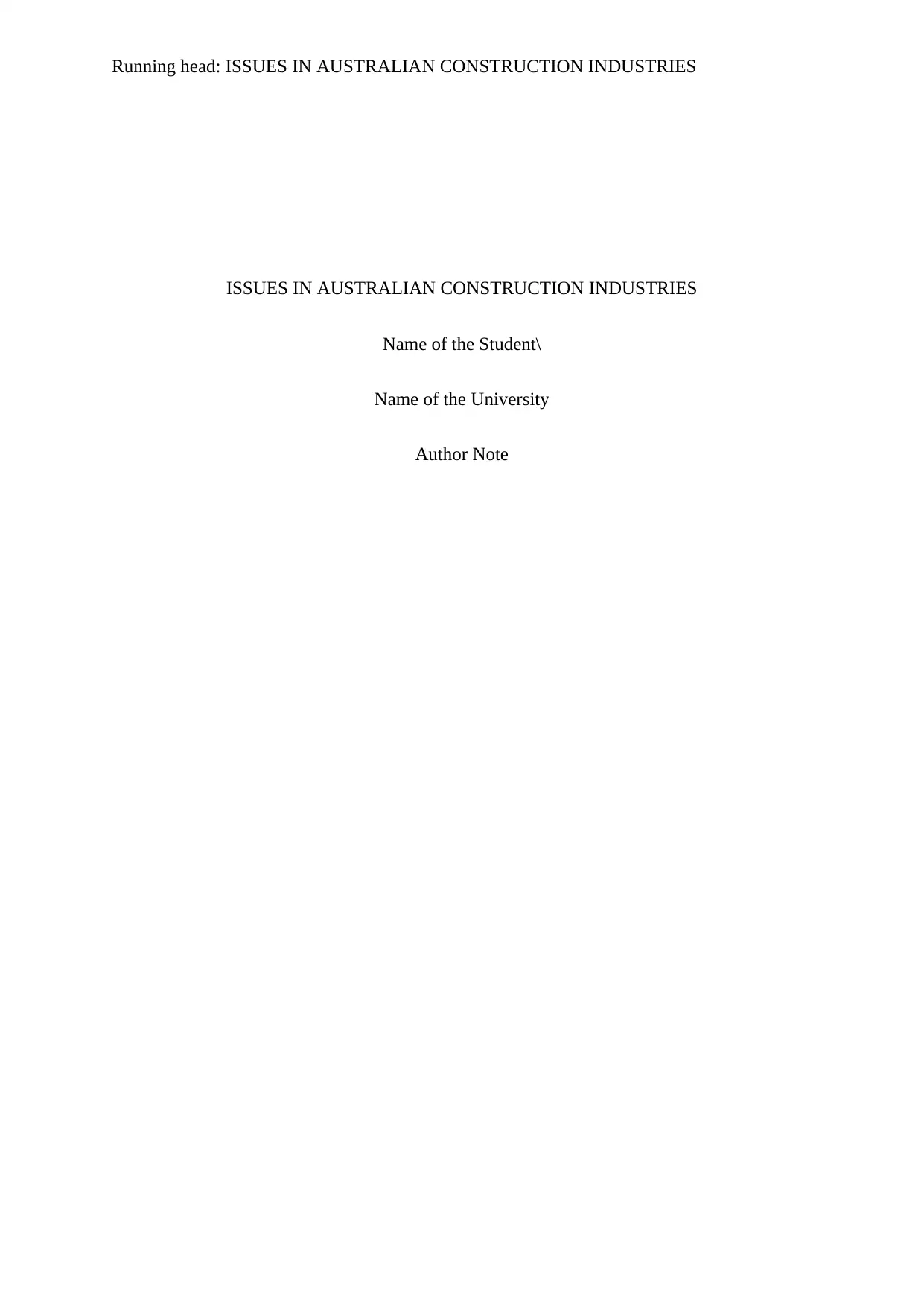
Running head: ISSUES IN AUSTRALIAN CONSTRUCTION INDUSTRIES
ISSUES IN AUSTRALIAN CONSTRUCTION INDUSTRIES
Name of the Student\
Name of the University
Author Note
ISSUES IN AUSTRALIAN CONSTRUCTION INDUSTRIES
Name of the Student\
Name of the University
Author Note
Paraphrase This Document
Need a fresh take? Get an instant paraphrase of this document with our AI Paraphraser
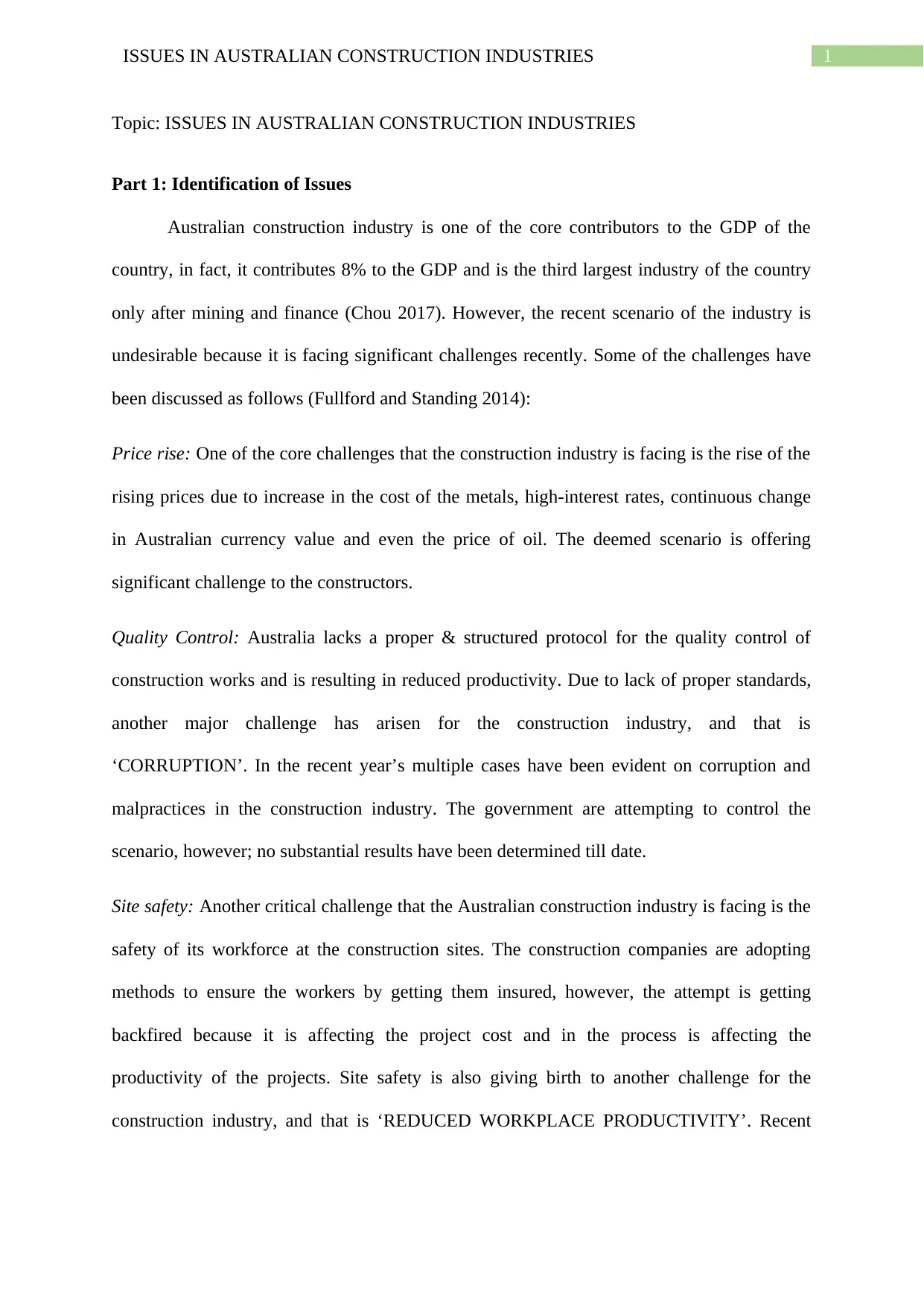
1ISSUES IN AUSTRALIAN CONSTRUCTION INDUSTRIES
Topic: ISSUES IN AUSTRALIAN CONSTRUCTION INDUSTRIES
Part 1: Identification of Issues
Australian construction industry is one of the core contributors to the GDP of the
country, in fact, it contributes 8% to the GDP and is the third largest industry of the country
only after mining and finance (Chou 2017). However, the recent scenario of the industry is
undesirable because it is facing significant challenges recently. Some of the challenges have
been discussed as follows (Fullford and Standing 2014):
Price rise: One of the core challenges that the construction industry is facing is the rise of the
rising prices due to increase in the cost of the metals, high-interest rates, continuous change
in Australian currency value and even the price of oil. The deemed scenario is offering
significant challenge to the constructors.
Quality Control: Australia lacks a proper & structured protocol for the quality control of
construction works and is resulting in reduced productivity. Due to lack of proper standards,
another major challenge has arisen for the construction industry, and that is
‘CORRUPTION’. In the recent year’s multiple cases have been evident on corruption and
malpractices in the construction industry. The government are attempting to control the
scenario, however; no substantial results have been determined till date.
Site safety: Another critical challenge that the Australian construction industry is facing is the
safety of its workforce at the construction sites. The construction companies are adopting
methods to ensure the workers by getting them insured, however, the attempt is getting
backfired because it is affecting the project cost and in the process is affecting the
productivity of the projects. Site safety is also giving birth to another challenge for the
construction industry, and that is ‘REDUCED WORKPLACE PRODUCTIVITY’. Recent
Topic: ISSUES IN AUSTRALIAN CONSTRUCTION INDUSTRIES
Part 1: Identification of Issues
Australian construction industry is one of the core contributors to the GDP of the
country, in fact, it contributes 8% to the GDP and is the third largest industry of the country
only after mining and finance (Chou 2017). However, the recent scenario of the industry is
undesirable because it is facing significant challenges recently. Some of the challenges have
been discussed as follows (Fullford and Standing 2014):
Price rise: One of the core challenges that the construction industry is facing is the rise of the
rising prices due to increase in the cost of the metals, high-interest rates, continuous change
in Australian currency value and even the price of oil. The deemed scenario is offering
significant challenge to the constructors.
Quality Control: Australia lacks a proper & structured protocol for the quality control of
construction works and is resulting in reduced productivity. Due to lack of proper standards,
another major challenge has arisen for the construction industry, and that is
‘CORRUPTION’. In the recent year’s multiple cases have been evident on corruption and
malpractices in the construction industry. The government are attempting to control the
scenario, however; no substantial results have been determined till date.
Site safety: Another critical challenge that the Australian construction industry is facing is the
safety of its workforce at the construction sites. The construction companies are adopting
methods to ensure the workers by getting them insured, however, the attempt is getting
backfired because it is affecting the project cost and in the process is affecting the
productivity of the projects. Site safety is also giving birth to another challenge for the
construction industry, and that is ‘REDUCED WORKPLACE PRODUCTIVITY’. Recent
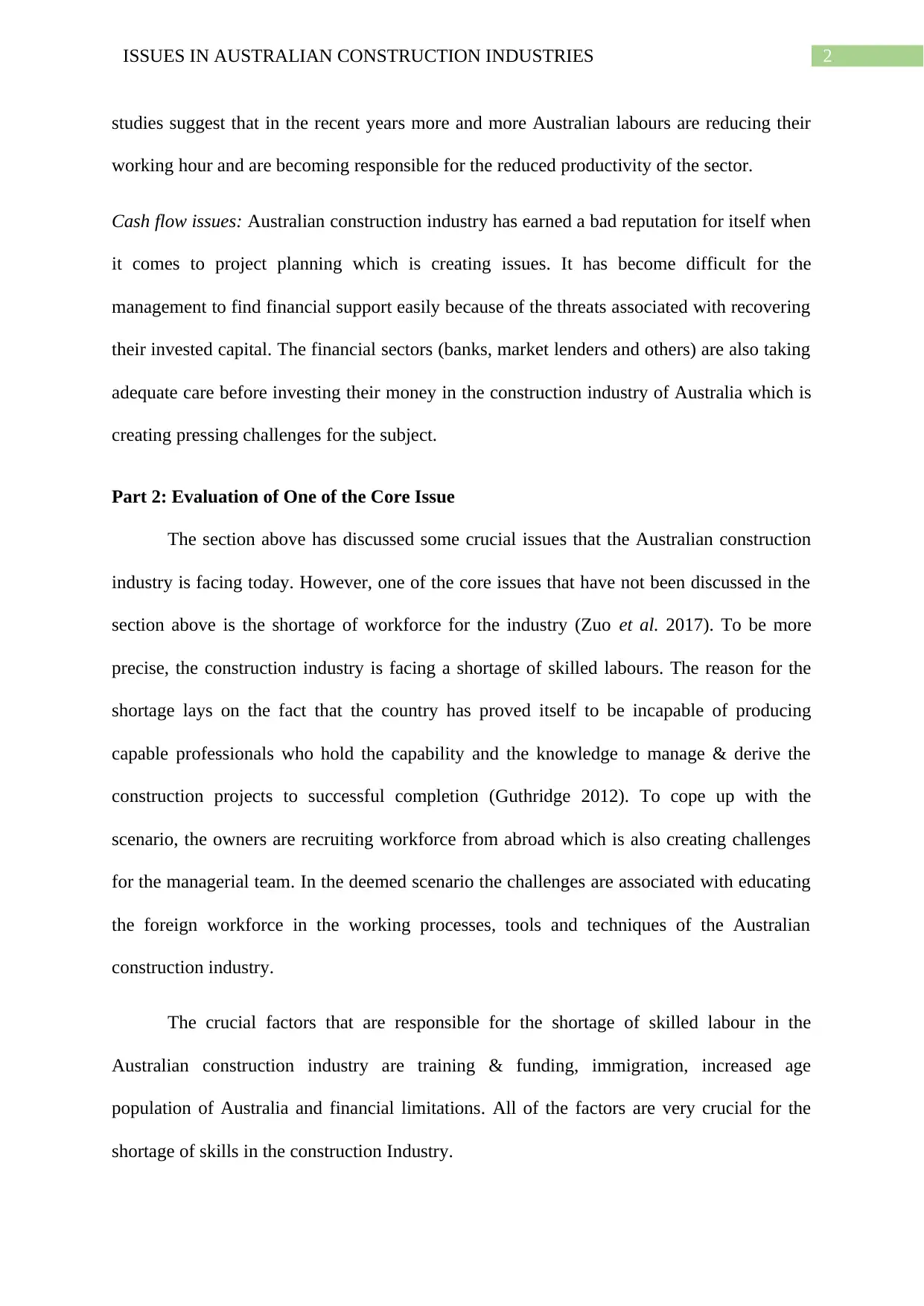
2ISSUES IN AUSTRALIAN CONSTRUCTION INDUSTRIES
studies suggest that in the recent years more and more Australian labours are reducing their
working hour and are becoming responsible for the reduced productivity of the sector.
Cash flow issues: Australian construction industry has earned a bad reputation for itself when
it comes to project planning which is creating issues. It has become difficult for the
management to find financial support easily because of the threats associated with recovering
their invested capital. The financial sectors (banks, market lenders and others) are also taking
adequate care before investing their money in the construction industry of Australia which is
creating pressing challenges for the subject.
Part 2: Evaluation of One of the Core Issue
The section above has discussed some crucial issues that the Australian construction
industry is facing today. However, one of the core issues that have not been discussed in the
section above is the shortage of workforce for the industry (Zuo et al. 2017). To be more
precise, the construction industry is facing a shortage of skilled labours. The reason for the
shortage lays on the fact that the country has proved itself to be incapable of producing
capable professionals who hold the capability and the knowledge to manage & derive the
construction projects to successful completion (Guthridge 2012). To cope up with the
scenario, the owners are recruiting workforce from abroad which is also creating challenges
for the managerial team. In the deemed scenario the challenges are associated with educating
the foreign workforce in the working processes, tools and techniques of the Australian
construction industry.
The crucial factors that are responsible for the shortage of skilled labour in the
Australian construction industry are training & funding, immigration, increased age
population of Australia and financial limitations. All of the factors are very crucial for the
shortage of skills in the construction Industry.
studies suggest that in the recent years more and more Australian labours are reducing their
working hour and are becoming responsible for the reduced productivity of the sector.
Cash flow issues: Australian construction industry has earned a bad reputation for itself when
it comes to project planning which is creating issues. It has become difficult for the
management to find financial support easily because of the threats associated with recovering
their invested capital. The financial sectors (banks, market lenders and others) are also taking
adequate care before investing their money in the construction industry of Australia which is
creating pressing challenges for the subject.
Part 2: Evaluation of One of the Core Issue
The section above has discussed some crucial issues that the Australian construction
industry is facing today. However, one of the core issues that have not been discussed in the
section above is the shortage of workforce for the industry (Zuo et al. 2017). To be more
precise, the construction industry is facing a shortage of skilled labours. The reason for the
shortage lays on the fact that the country has proved itself to be incapable of producing
capable professionals who hold the capability and the knowledge to manage & derive the
construction projects to successful completion (Guthridge 2012). To cope up with the
scenario, the owners are recruiting workforce from abroad which is also creating challenges
for the managerial team. In the deemed scenario the challenges are associated with educating
the foreign workforce in the working processes, tools and techniques of the Australian
construction industry.
The crucial factors that are responsible for the shortage of skilled labour in the
Australian construction industry are training & funding, immigration, increased age
population of Australia and financial limitations. All of the factors are very crucial for the
shortage of skills in the construction Industry.
⊘ This is a preview!⊘
Do you want full access?
Subscribe today to unlock all pages.

Trusted by 1+ million students worldwide
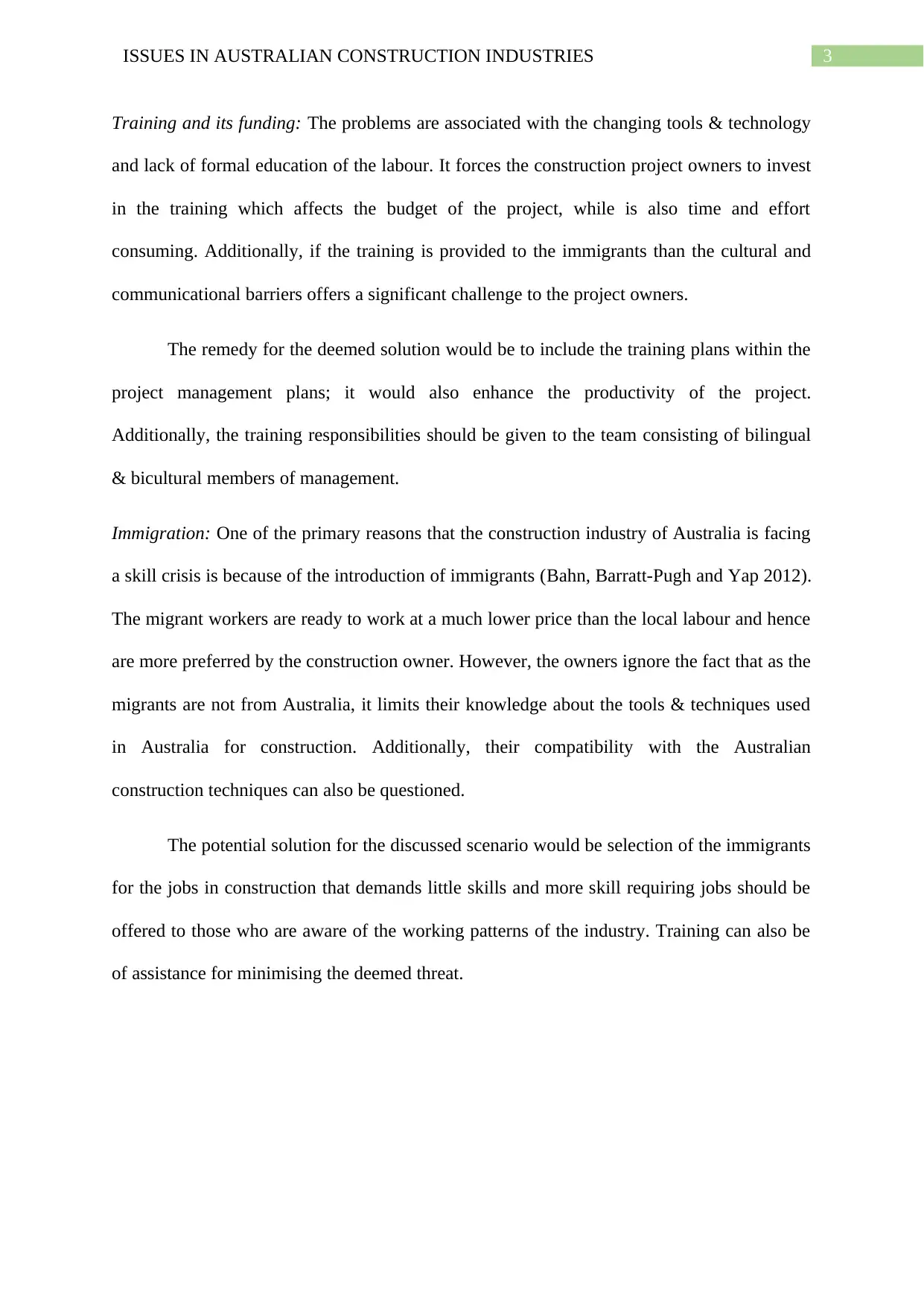
3ISSUES IN AUSTRALIAN CONSTRUCTION INDUSTRIES
Training and its funding: The problems are associated with the changing tools & technology
and lack of formal education of the labour. It forces the construction project owners to invest
in the training which affects the budget of the project, while is also time and effort
consuming. Additionally, if the training is provided to the immigrants than the cultural and
communicational barriers offers a significant challenge to the project owners.
The remedy for the deemed solution would be to include the training plans within the
project management plans; it would also enhance the productivity of the project.
Additionally, the training responsibilities should be given to the team consisting of bilingual
& bicultural members of management.
Immigration: One of the primary reasons that the construction industry of Australia is facing
a skill crisis is because of the introduction of immigrants (Bahn, Barratt-Pugh and Yap 2012).
The migrant workers are ready to work at a much lower price than the local labour and hence
are more preferred by the construction owner. However, the owners ignore the fact that as the
migrants are not from Australia, it limits their knowledge about the tools & techniques used
in Australia for construction. Additionally, their compatibility with the Australian
construction techniques can also be questioned.
The potential solution for the discussed scenario would be selection of the immigrants
for the jobs in construction that demands little skills and more skill requiring jobs should be
offered to those who are aware of the working patterns of the industry. Training can also be
of assistance for minimising the deemed threat.
Training and its funding: The problems are associated with the changing tools & technology
and lack of formal education of the labour. It forces the construction project owners to invest
in the training which affects the budget of the project, while is also time and effort
consuming. Additionally, if the training is provided to the immigrants than the cultural and
communicational barriers offers a significant challenge to the project owners.
The remedy for the deemed solution would be to include the training plans within the
project management plans; it would also enhance the productivity of the project.
Additionally, the training responsibilities should be given to the team consisting of bilingual
& bicultural members of management.
Immigration: One of the primary reasons that the construction industry of Australia is facing
a skill crisis is because of the introduction of immigrants (Bahn, Barratt-Pugh and Yap 2012).
The migrant workers are ready to work at a much lower price than the local labour and hence
are more preferred by the construction owner. However, the owners ignore the fact that as the
migrants are not from Australia, it limits their knowledge about the tools & techniques used
in Australia for construction. Additionally, their compatibility with the Australian
construction techniques can also be questioned.
The potential solution for the discussed scenario would be selection of the immigrants
for the jobs in construction that demands little skills and more skill requiring jobs should be
offered to those who are aware of the working patterns of the industry. Training can also be
of assistance for minimising the deemed threat.
Paraphrase This Document
Need a fresh take? Get an instant paraphrase of this document with our AI Paraphraser
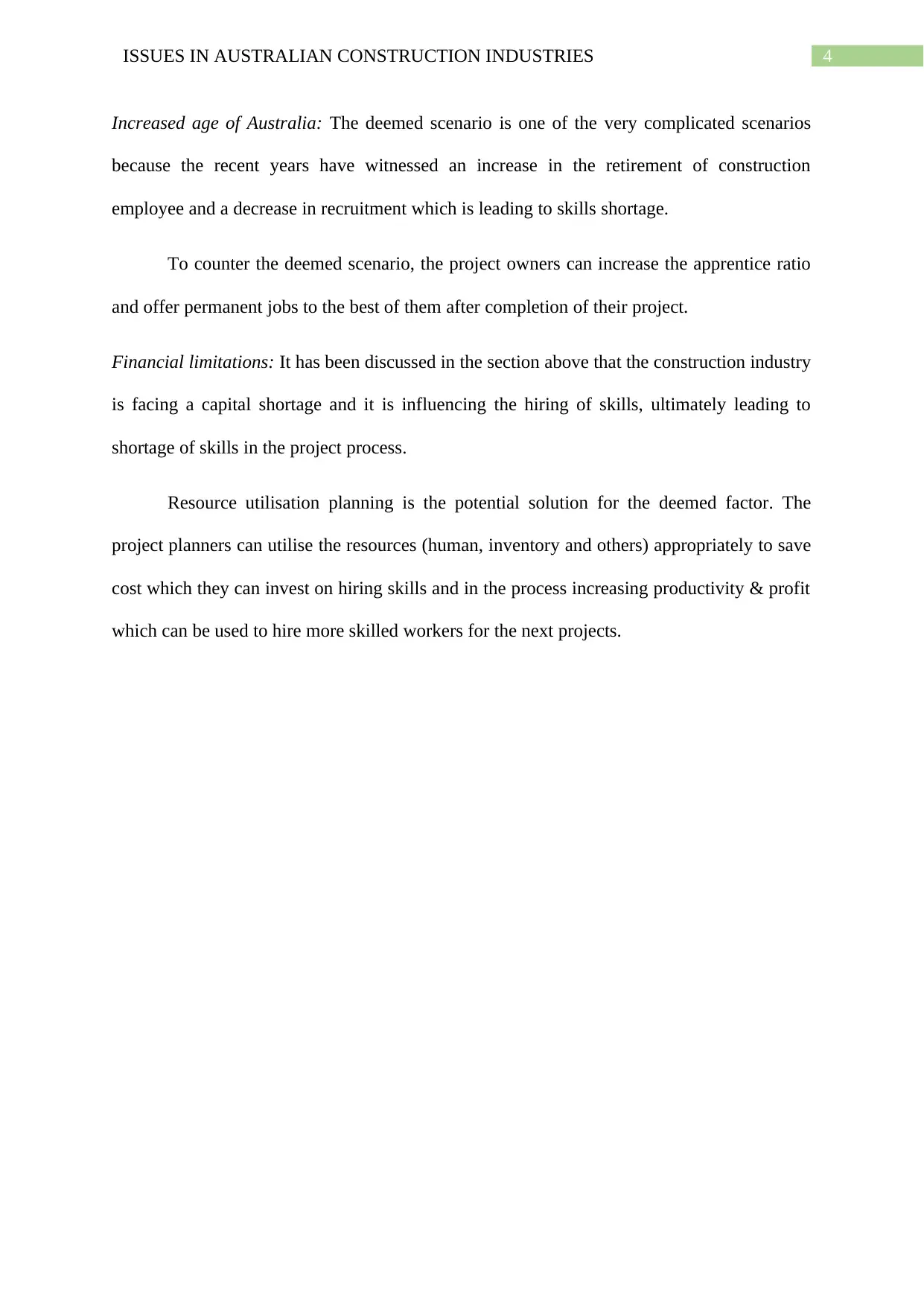
4ISSUES IN AUSTRALIAN CONSTRUCTION INDUSTRIES
Increased age of Australia: The deemed scenario is one of the very complicated scenarios
because the recent years have witnessed an increase in the retirement of construction
employee and a decrease in recruitment which is leading to skills shortage.
To counter the deemed scenario, the project owners can increase the apprentice ratio
and offer permanent jobs to the best of them after completion of their project.
Financial limitations: It has been discussed in the section above that the construction industry
is facing a capital shortage and it is influencing the hiring of skills, ultimately leading to
shortage of skills in the project process.
Resource utilisation planning is the potential solution for the deemed factor. The
project planners can utilise the resources (human, inventory and others) appropriately to save
cost which they can invest on hiring skills and in the process increasing productivity & profit
which can be used to hire more skilled workers for the next projects.
Increased age of Australia: The deemed scenario is one of the very complicated scenarios
because the recent years have witnessed an increase in the retirement of construction
employee and a decrease in recruitment which is leading to skills shortage.
To counter the deemed scenario, the project owners can increase the apprentice ratio
and offer permanent jobs to the best of them after completion of their project.
Financial limitations: It has been discussed in the section above that the construction industry
is facing a capital shortage and it is influencing the hiring of skills, ultimately leading to
shortage of skills in the project process.
Resource utilisation planning is the potential solution for the deemed factor. The
project planners can utilise the resources (human, inventory and others) appropriately to save
cost which they can invest on hiring skills and in the process increasing productivity & profit
which can be used to hire more skilled workers for the next projects.
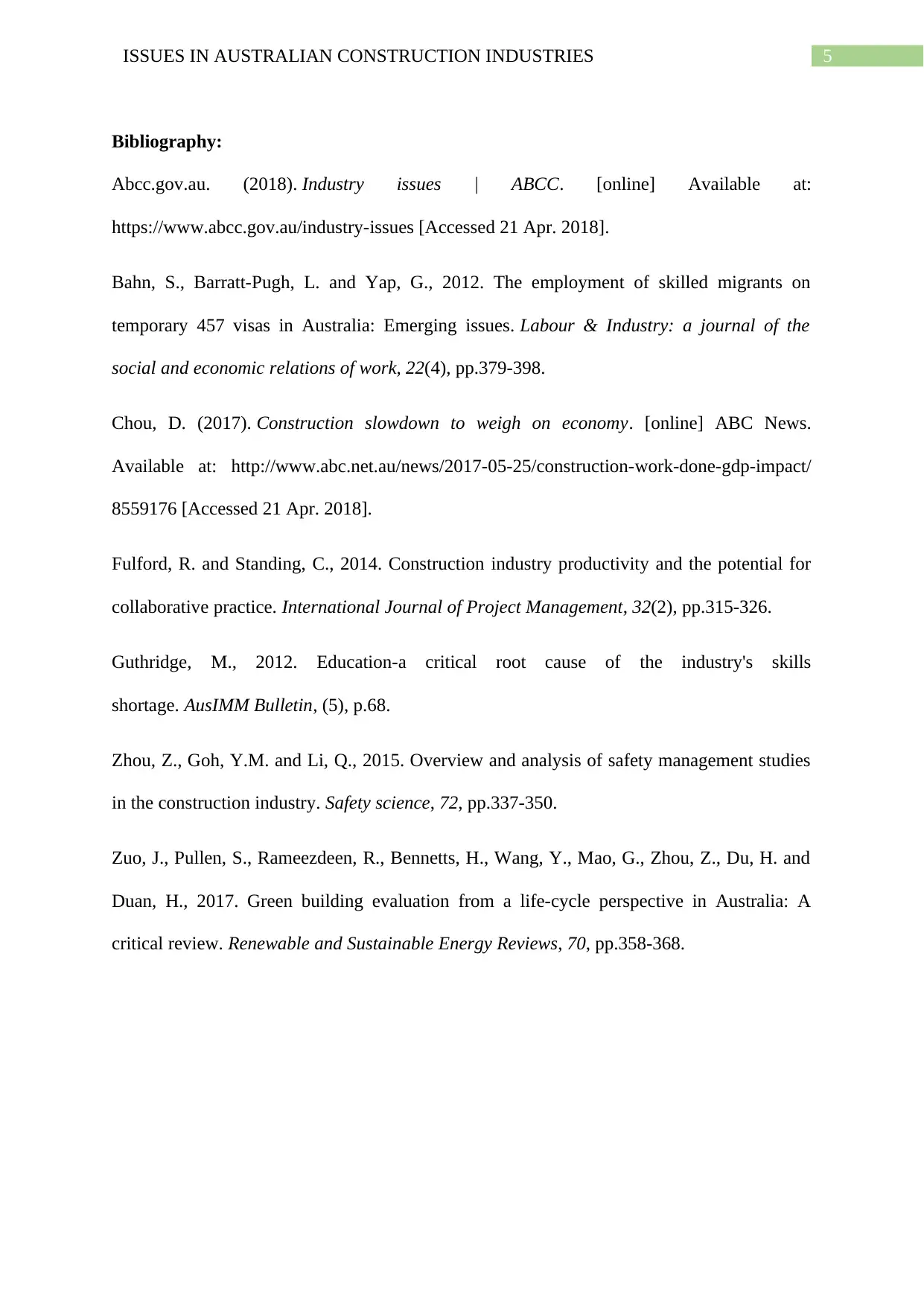
5ISSUES IN AUSTRALIAN CONSTRUCTION INDUSTRIES
Bibliography:
Abcc.gov.au. (2018). Industry issues | ABCC. [online] Available at:
https://www.abcc.gov.au/industry-issues [Accessed 21 Apr. 2018].
Bahn, S., Barratt-Pugh, L. and Yap, G., 2012. The employment of skilled migrants on
temporary 457 visas in Australia: Emerging issues. Labour & Industry: a journal of the
social and economic relations of work, 22(4), pp.379-398.
Chou, D. (2017). Construction slowdown to weigh on economy. [online] ABC News.
Available at: http://www.abc.net.au/news/2017-05-25/construction-work-done-gdp-impact/
8559176 [Accessed 21 Apr. 2018].
Fulford, R. and Standing, C., 2014. Construction industry productivity and the potential for
collaborative practice. International Journal of Project Management, 32(2), pp.315-326.
Guthridge, M., 2012. Education-a critical root cause of the industry's skills
shortage. AusIMM Bulletin, (5), p.68.
Zhou, Z., Goh, Y.M. and Li, Q., 2015. Overview and analysis of safety management studies
in the construction industry. Safety science, 72, pp.337-350.
Zuo, J., Pullen, S., Rameezdeen, R., Bennetts, H., Wang, Y., Mao, G., Zhou, Z., Du, H. and
Duan, H., 2017. Green building evaluation from a life-cycle perspective in Australia: A
critical review. Renewable and Sustainable Energy Reviews, 70, pp.358-368.
Bibliography:
Abcc.gov.au. (2018). Industry issues | ABCC. [online] Available at:
https://www.abcc.gov.au/industry-issues [Accessed 21 Apr. 2018].
Bahn, S., Barratt-Pugh, L. and Yap, G., 2012. The employment of skilled migrants on
temporary 457 visas in Australia: Emerging issues. Labour & Industry: a journal of the
social and economic relations of work, 22(4), pp.379-398.
Chou, D. (2017). Construction slowdown to weigh on economy. [online] ABC News.
Available at: http://www.abc.net.au/news/2017-05-25/construction-work-done-gdp-impact/
8559176 [Accessed 21 Apr. 2018].
Fulford, R. and Standing, C., 2014. Construction industry productivity and the potential for
collaborative practice. International Journal of Project Management, 32(2), pp.315-326.
Guthridge, M., 2012. Education-a critical root cause of the industry's skills
shortage. AusIMM Bulletin, (5), p.68.
Zhou, Z., Goh, Y.M. and Li, Q., 2015. Overview and analysis of safety management studies
in the construction industry. Safety science, 72, pp.337-350.
Zuo, J., Pullen, S., Rameezdeen, R., Bennetts, H., Wang, Y., Mao, G., Zhou, Z., Du, H. and
Duan, H., 2017. Green building evaluation from a life-cycle perspective in Australia: A
critical review. Renewable and Sustainable Energy Reviews, 70, pp.358-368.
⊘ This is a preview!⊘
Do you want full access?
Subscribe today to unlock all pages.

Trusted by 1+ million students worldwide
1 out of 6
Related Documents
Your All-in-One AI-Powered Toolkit for Academic Success.
+13062052269
info@desklib.com
Available 24*7 on WhatsApp / Email
![[object Object]](/_next/static/media/star-bottom.7253800d.svg)
Unlock your academic potential
Copyright © 2020–2025 A2Z Services. All Rights Reserved. Developed and managed by ZUCOL.




